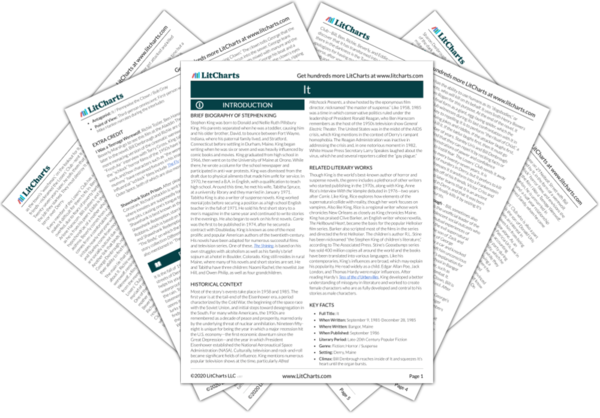Welcome to the LitCharts study guide on Stephen King's It. Created by the original team behind SparkNotes, LitCharts are the world's best literature guides.
It: Introduction
It: Plot Summary
It: Detailed Summary & Analysis
It: Themes
It: Quotes
It: Characters
It: Symbols
It: Theme Wheel
Brief Biography of Stephen King

Historical Context of It
Other Books Related to It
- Full Title: It
- When Written: September 9, 1981-December 28, 1985
- Where Written: Bangor, Maine
- When Published: September 1986
- Literary Period: Late-20th Century Popular Fiction
- Genre: Fiction; Horror / Suspense
- Setting: Derry, Maine
- Climax: Bill Denbrough reaches inside of It and squeezes It’s heart until the organ bursts.
- Antagonist: It / Pennywise the Clown / Bob Gray
- Point of View: Third-person omniscient; First-person when Mike Hanlon narrates during the interludes
Extra Credit for It
I Was a Teenage Werewolf. Richie Tozier, Ben Hanscom, and Beverly Marsh go to see this film at the Aladdin Theater and, later in the novel, Bill Denbrough and Richie are chased by a more menacing version of the cinematic werewolf. During a “Fresh Air” interview with Terry Gross, King talked about how the “schlock” horror films of the 1950s have influenced his work, and how characters such as “the werewolf” and “the mummy” have remained fixtures in his imagination. Other influential “schlock” films include The Fly and It Came From Outer Space, both of which are also mentioned in the novel.
Shawshank State Prison. After pleading guilty to killing Dorsey Corcoran, Richard Macklin is sent to Shawshank—a place where inmates are supposedly forced to work in the prison’s lime pits, causing one’s tongue to turn green. The fictional Shawshank is best known as the setting of the film The Shawshank Redemption, starring Morgan Freeman and Tim Robbins, which is based on King’s short story, “Rita Hayworth and Shawshank Redemption.” This story appears—along with “The Body,” on which the hit film Stand By Me is based—in the story collection Different Seasons. Shawshank State Prison is also mentioned in “The Body.”







